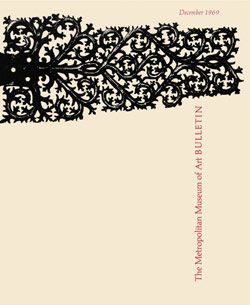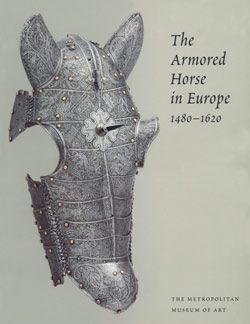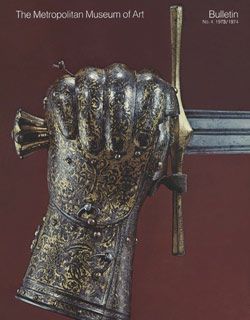Chess Piece in the Form of a Knight
Western European, possibly England
This remarkably detailed ivory chessman––the solitary survivor of an otherwise vanished set––provides a rare representation of a complete late-fourteenth-century armor for both man and horse. Moreover, it appears to be one of the earliest of such depictions sculptured fully in the round to survive from before the sixteenth century.
The armor of both man and horse can be dated to the second half of the fourteenth century. That of the man-at-arms consists of a visored bascinet with a mail neck protection (aventail), a mail shirt with long sleeves, and further plate armor for the hands (gauntlets of so-called hourglass shape), knees (poleyns), and the lower leg (greaves). The figure is further protected by an early form of horseman's shield called a targe. A large sword, known as a "great sword" or "war sword," is suspended at his left side, while his right hand formerly held a lance resting in front of the saddle bow; only the lower part of the lance survives.
The most notable element of the bard is the large shaffron, which encompasses the entire head of the animal and is shaped with a distinct medial ridge. The shaffron extends from behind the skill to the point of the muzzle, where it is embossed over the nostrils and pierced for ventilation. The area of the ears is too worn to reveal any defense, but the eyes are protected by cuplike guards. A stepped line at either side of the head suggests that the large main plate is connected by hinges to further plates protecting the underside of the horse's lower jaw. The shaffron is extended at the back by two crinet lames that appear to encircle the neck completely. A full mail bard, or trapper, protects the lower neck, chest, and hindquarters and originally extended to the animal's knee and hock, respectively (the legs are now missing). On top of this mail trapper, the horse wears four panels. The first, shaped like a peytral, is suspended from the base of the neck across the chest; a square panel at either side of the hindquarters and a shield-shaped one across the rear, completely concealing the tail, are suspended from a system of straps across the croup. These panels, the front and side ones with a dagged lower edge, presumably are made from textile, hardened leather, or textile covering such leather. Serving as both additional protection and adornment, they were probably painted or embroidered with the rider's coat of arms.
The lack of plate armor for the man's torso and arms, or of a textile covering for his body, is unusual for the late fourteenth century, but representations of this particular type of shaffron shown here can be found from the last half of the fouteenth century until at least the second decade of the fifteenth. The shaffron's cuplike eye guards, however, together with the lack of plate armor for the rider and the fact that mail trappers went out of use rapidly after the beginning of the fifteenth century, argue for dating this chessman to the last quarter of the fourteenth century.
This image cannot be enlarged, viewed at full screen, or downloaded.
This artwork is meant to be viewed from right to left. Scroll left to view more.








